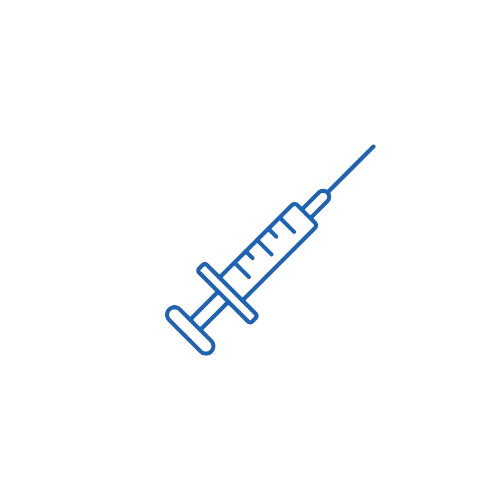Nalbuphine
Medicines List
All MedicineIndications
Approved Indications:
- Moderate to Severe Pain:
- Effective for managing moderate to severe acute pain, including post-operative pain, musculoskeletal trauma, and other painful conditions.
- Obstetric Analgesia:
- Used for labor pain relief without significant respiratory depression in the newborn.
- Adjunct to General Anesthesia:
- Administered before, during, or after anesthesia to supplement analgesia during surgical procedures.
- Preoperative and Postoperative Analgesia:
- Employed in hospital settings to relieve pain before or after surgery.
Clinically Accepted (Off-label) Uses:
- Opioid-Induced Pruritus:
- Used to treat itching associated with epidural or intrathecal opioid administration.
- Opioid Withdrawal Management:
- Occasionally used to relieve withdrawal symptoms in opioid-dependent patients during tapering.
- Procedural Sedation in Minor Procedures:
- Provides analgesia and sedation for short diagnostic or surgical procedures under monitored care.
Dosage & Administration
Route of Administration: Intramuscular (IM), Intravenous (IV), Subcutaneous (SC)
Adults:
- Moderate to Severe Pain:
- 10 mg IM/IV/SC every 3 to 6 hours as needed.
- Maximum: 20 mg per dose; 160 mg/day.
- Adjunct to Anesthesia:
- 0.3 mg/kg IV slowly over 10 to 15 minutes, as part of surgical analgesia.
- May be repeated every 3 to 6 hours if required.
- Obstetric Analgesia (Labor Pain):
- 10 mg IV or IM every 3 hours as needed.
- Maximum: 20 mg total during labor.
Pediatric Patients (≥1 year):
- Pain Management:
- 0.1 to 0.2 mg/kg/dose IV/IM/SC every 3 to 6 hours as needed.
- Use under close clinical supervision.
Elderly:
- Start at the lower end of the dosing range (e.g., 5 mg per dose).
- Monitor closely for signs of sedation or respiratory depression.
Renal Impairment:
- Use with caution; consider dose reduction and monitor for accumulation or prolonged effect.
Hepatic Impairment:
- Reduce initial dose and extend dosing interval due to slower metabolism.
- Monitor for CNS or respiratory depression.
Mechanism of Action (MOA)
Nalbuphine is a mixed opioid agonist-antagonist. It acts as an agonist at kappa-opioid receptors, producing analgesia, sedation, and limited euphoria. Simultaneously, it acts as a partial antagonist at mu-opioid receptors, reducing the risk of respiratory depression, euphoria, and physical dependence typically associated with mu-agonists. This dual activity allows it to provide effective pain relief while minimizing the risk of opioid-related side effects such as overdose and addiction. The ceiling effect on respiratory depression is a significant safety advantage.
Pharmacokinetics
- Absorption: Rapidly absorbed following IM, IV, or SC administration.
- Peak Plasma Time:
- IV: Immediate onset
- IM: Peak effect in 30–60 minutes
- Bioavailability: 100% (IV); ~40% (IM)
- Distribution: Widely distributed; crosses placenta and may enter breast milk.
- Plasma Protein Binding: ~50%
- Metabolism: Hepatic, primarily via conjugation (glucuronidation).
- Elimination Half-life: 4.9 ± 0.8 hours
- Excretion: Primarily via urine (~80%); minor fecal excretion
- Onset of Action:
- IV: 2 to 3 minutes
- IM: 15 minutes
- Duration of Action: 3 to 6 hours
Pregnancy Category & Lactation
- Pregnancy Category (FDA): Category B
- No evidence of fetal harm in animal studies.
- Used during labor but may cause transient respiratory depression in the neonate if administered shortly before delivery.
- Lactation:
- Small amounts are excreted into breast milk.
- Generally considered safe during breastfeeding if used for a short duration and infant is monitored for sedation, apnea, or feeding difficulties.
Therapeutic Class
- Primary Class: Opioid Analgesic
- Subclass: Mixed Opioid Agonist-Antagonist (Kappa receptor agonist / Mu receptor antagonist)
Contraindications
- Known hypersensitivity to nalbuphine or any of its components
- Significant respiratory depression in the absence of resuscitative equipment
- Acute bronchial asthma in an unmonitored setting
- Patients dependent on full mu-opioid agonists (risk of precipitated withdrawal)
- Head injuries or elevated intracranial pressure (may obscure neurologic evaluation)
Warnings & Precautions
- Respiratory Depression: May still occur, particularly in higher doses or when combined with other CNS depressants.
- Opioid Withdrawal: In opioid-dependent individuals, nalbuphine may precipitate withdrawal symptoms.
- CNS Depression: Impairs mental and physical capabilities; caution in activities requiring alertness.
- Cardiovascular Effects: May cause hypotension, especially in volume-depleted or elderly patients.
- Head Trauma: May increase intracranial pressure; use with caution.
- Hepatic/Renal Impairment: Slower metabolism or excretion may increase toxicity risk.
- Use in Neonates: Respiratory depression in newborns if administered shortly before delivery.
Side Effects
Common:
- Central Nervous System:
- Sedation, dizziness, headache, drowsiness
- Gastrointestinal:
- Nausea, vomiting, dry mouth, constipation
- Dermatologic:
- Sweating, pruritus
Less Common / Serious:
- Respiratory depression
- Hypotension, bradycardia
- Confusion, hallucinations, dysphoria
- Allergic reactions (rare)
- Neonatal respiratory depression (if used during labor)
- Withdrawal syndrome in opioid-dependent patients
Drug Interactions
- CNS Depressants (e.g., alcohol, benzodiazepines, sedatives):
- Additive effects → increased sedation and respiratory depression.
- Opioid Agonists (e.g., morphine, fentanyl):
- Nalbuphine may antagonize their effects or trigger withdrawal in opioid-dependent patients.
- Monoamine Oxidase Inhibitors (MAOIs):
- Use not recommended due to potential for exaggerated CNS depression or serotonin toxicity.
- Enzyme Interactions:
- Not significantly metabolized by CYP450 enzymes; low risk for major CYP450 interactions.
Recent Updates or Guidelines
- Regulatory Status:
- Nalbuphine is not scheduled under the U.S. Controlled Substances Act due to low abuse potential.
- WHO & National Guidelines:
- Still recommended as a safe analgesic during labor and in post-operative settings, especially where opioid abuse is a concern.
- New Safety Data:
- No recent major safety warnings; monitoring advised for respiratory effects, especially in neonates and elderly.
Storage Conditions
- Temperature: Store at 20°C to 25°C (68°F to 77°F)
- Permissible Range: 15°C to 30°C
- Protection:
- Protect from light and heat.
- Keep in original packaging until use.
- Handling:
- Do not freeze.
- Inspect vial before use; discard if solution is cloudy or discolored.
- Multi-dose Containers: Use aseptic technique; follow hospital policy for expiration after opening.
